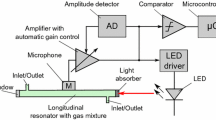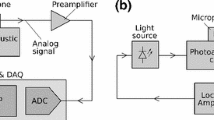Abstract
In conventional photoacoustic setups, the photoacoustic signal results from stimulation of a sample placed in the photoacoustic cell by the light modulated at a selected frequency. The signal can be amplified in a resonance photoacoustic cell. For this purpose, different types of acoustic resonators are used. Acoustic resonators are passive, frequency selective elements. An acoustic resonator used in a photoacoustic cell offers the opportunity to design a system working on a basis similar to that of a self-oscillating generator. The geometrical dimensions of an acoustic resonator, and the temperature, composition, and concentration of substances in the gas filling its interior determine the resonance frequency. In conventional photoacoustic setups, in which the resonance method is used, the variability of parameters requires continuous adjusting of or searching for the actual resonance frequency. Use of a fixed and arbitrary selected modulation frequency of the light beam can cause considerable errors in detection of substances in the sample or in determination of their concentration. Unlike conventional photoacoustic methods, the frequency of a photoacoustic signal in an improved photoacoustic generator is self-tuned to the actual resonant frequency of the photoacoustic cell. The improved photoacoustic generator operates without an external circuit that controls the optical modulator. The improved photoacoustic generator has been tested in different measurements of the concentration of methane in air. The automatic gain control signal can be used for determination of the absorption by the sample.
Similar content being viewed by others
Avoid common mistakes on your manuscript.
1 Introduction
One of the reasons why photoacoustic methods are so attractive is their ability to measure low concentrations of substances. Such measurements are often associated with the necessity to detect very low amplitude signals which are comparable to the noise level. One of the methods used commonly to amplify a weak photoacoustic signal uses acoustic resonance cells [1–6]. In that case, the photoacoustic cell is stimulated by a light beam modulated at a frequency equal to the resonant frequency of the cell. The resonant photoacoustic signal is amplified, while amplitudes of signals at other frequencies are reduced.
It is known that the resonance frequency of each acoustic resonator depends on the speed of sound in the gas sample filling the resonator. In photoacoustic measurements, samples with different gas compositions can be used. So, the gas filling a photoacoustic cell may have different chemical compositions and thermodynamic parameters. These parameters influence the speed of sound, which directly affects the resonant frequency [7–11]. Examples of changes of the resonant frequency of a Helmholtz resonator are shown in Fig. 1. These experimental results show that the signal amplitude and the resonant frequency of the photoacoustic cell depend strongly on the methane concentration. Although it is not a problem to modulate a light beam with a given frequency, it may be not easy to obtain information about the actual resonant frequency. Therefore, in conventional measuring systems used in photoacoustic experiments, the monitoring of environmental factors are applied. On the basis of these factors, the appropriate calculations and adequate corrections of the corresponding frequency of the light beam modulator are carried out. Without such corrections, even a small deviation of the modulation frequency from the actual resonant frequency of the photoacoustic cell changes the amplitude of the photoacoustic response [12]. This could, as a consequence, result in a strong decrease of the photoacoustic signal amplitude. Additionally, delays in the sensor’s reaction time complicate the measurements. A solution in which the measurements are based on a photoacoustic generator, which automatically tunes to the frequency defined by the actual resonant frequency of the photoacoustic cell, would solve this problem. The first experimental application of the photoacoustic generator was presented by Borowski and Starecki [13]. The concept was based on incorporation of the Helmholtz resonator into a positive feedback loop circuit similar to the solution used in electronic oscillators [14, 15]. The acoustic signal induced by the photoacoustic effect was converted by an electret microphone into an electrical signal and then amplified. This signal controlled the light source modulation. Application of a positive feedback loop was the main feature distinguishing the mentioned solution from previous known methods of the photoacoustic signal excitation. It should be noted that operation of the photoacoustic generator was based on the use of very high gain and a positive feedback loop. Further research on the self-oscillating photoacoustic generator displayed distortions and instability on the generated signal [16]. In order to work exactly on the resonant frequency, a sinusoidal signal was required. This paper describes an improved photoacoustic generator, which is more stable and produces sinusoidal oscillations.
2 Introduction to Photoacoustic Generator Theory
Generally, self-oscillating generators are circuits in which the frequency is produced without the need of supplying any external control signal. The idea of a sinusoidal wave photoacoustic generator is substantially similar to the idea of electronic sinusoidal wave generators, but instead of an LC or RC resonant circuit, a resonant photoacoustic cell is used. The main differences between the photoacoustic generator and the conventional electronic generator are: resonant frequency (determined by the properties of the acoustic resonator), a different technique of resonant circuit stimulation (light pulses), and a different way of outputting the signal from the resonant circuit (acoustic–electric transducer, typically a microphone). Similar to electronic oscillators, the photoacoustic generator must satisfy at the same time amplitude and phase conditions. In the case of the photoacoustic generator, in order to excite oscillations, the presence of the photoacoustic signal must appear as a result of the release of the energy of a light beam absorbed by the sample. This means that the light used for stimulation of the photoacoustic generator must include wavelengths from the absorption spectrum of the substance contained in the sample. The overall concept of the first circuit of the photoacoustic self-oscillating generator is shown in Fig. 2. The first approach to the photoacoustic generator was composed of: a light source (LED diodes), an LED driver, a photoacoustic cell, a microphone, and an electronic amplifier. All the elements forming the photoacoustic generator are connected in a closed circuit, thus creating a positive feedback loop. The frequency of generated oscillations is determined by the resonance of the photoacoustic cell.
3 Experimental Setup of the Improved Photoacoustic Generator
The improved photoacoustic generator has been tested experimentally; a block diagram is shown in Fig. 3.
Comparing the improved photoacoustic generator (Fig. 2) with the first version of the photoacoustic generator circuit (Fig. 1), the improved photoacoustic generator was significantly modified by adding a differential amplifier stage and a diode detector, which are parts of an automatic gain control (AGC) loop. The concept of the improved photoacoustic generator was tested by measuring samples with different methane concentrations. The measuring system consists of: an electronic circuit of the improved photoacoustic generator, an acoustic resonator (Helmholtz resonator with a sample cavity volume of 2 cm\(^{3})\), a microphone cavity volume of 4 cm\(^{3}\), a duct length of 15 mm, a duct diameter of 4 mm, a source of light (91 infrared LEDs, 890 nm), and a MEMS microphone. In the measurements, ten samples of methane in air mixtures were used. Gaseous samples were prepared by combining them in one large syringe, measured by using scaled syringe portions of 99.999 pure methane and portions of air. For homogenization, the gas samples were mixed. The methane concentration was gradually increased by increments of 10 % volume fraction in each gas sample, reaching finally 100 % concentration. Such samples were injected into the photoacoustic cell. A few seconds after the sample injection, the inlet and outlet valves were closed and measurements of the frequency and the AGC signal level of the generator were performed. All experiments were carried out at \(25\,^\circ \mathrm{C}\). Figure 4 shows that the operation frequency of the improved photoacoustic generator depends on the methane concentration. Figure 5 shows how the AGC signal level in the improved photoacoustic generator depends on the methane concentration.
4 Experiment Results
The improved photoacoustic generator produces an oscillation immediately after the power is turned on. The oscillation frequency of the improved photoacoustic generator changes proportionally with the methane concentration in the gas sample, varying from 1410 Hz with the gas sample containing 10 % of methane in air to 1715 Hz with 100 % methane concentration. For all measured gas samples, the frequency of the improved photoacoustic generator is self-tuned to the actual resonant frequency of the photoacoustic cell. The resonant frequency depends on the gas composition due to its influence on the speed of sound. So, the variation of the photoacoustic cell resonance frequency was about 300 Hz. Over the whole range of the methane concentration, the amplitude of oscillations was maintained at a constant level. The automatic gain control loop delivers a DC voltage at the output of the detector, for which the level changes according to the methane concentration in the gas sample and shows high linearity over the whole tested concentration range.
5 Conclusions
A positive feedback loop with automatic gain control efficiently controls operation of the photoacoustic generator. The frequency of the photoacoustic signal produced by the improved photoacoustic generator changes proportionally with gas concentration over the whole range of concentrations, i.e., from 10 % to 100 % volume fraction of methane in the air. Contrary to the conventional photoacoustic method, the improved photoacoustic generator always produces a photoacoustic signal at the actual resonant frequency of the photoacoustic cell. Since the sample composition has significant influence on the speed of sound, which affects the resonant frequency, self-tuning to the resonance is an important feature, especially if one is dealing with samples for which these parameters have a significant impact on the resonant frequency. As a result, the photoacoustic signal can be obtained at the maximum of the resonance curve, not on the slope. The AGC signal (internal negative feedback loop) controls and maintains the amplitude of the oscillations at a constant level. The level of the AGC signal correlates with the methane concentration in the sample. The feature of self-tuning to the cell resonance is advantageous in the case of high Q-factor resonators.
References
R.S. Quimby, P.M. Selzer, W.M. Yen, Appl. Opt. 10, 2630 (1977)
W.A. McClenny, C.A. Bennett Jr., G.M. Russwurm, R. Richmond, Appl. Opt. 4, 650 (1981)
J. Pelzl, K. Klein, O. Nordhaus, Appl. Opt. 1, 94 (1982)
D. Pereira, A. Scalabrin, Infrared Phys. 6, 549 (1992)
V. Zeninari, V.A. Kapitanov, D. Courtois, Yu.N. Ponomarev, Infrared Phys. 1, 1 (1999)
A. Miklós, P. Hess, Z. Bozóki, Rev. Sci. Instrum. 72, 1937 (2001)
M.F. Costa Gomes, J.P.M. Trusler, J. Chem, Thermodyn. 9, 1121 (1998)
B.A. Younglove, N.V. Frederick, Int. J. Thermophys. 5, 897 (1990)
C. Fischer, E. Sorokin, I.T. Sorokina, M.W. Sigrist, Opt. Lasers Eng. 43, 573 (2005)
J.-P. Besson, Photoacoustic Spectroscopy for Multi-gas Sensing Using Near Infrared Lasers, Ph.D. thesis No. 3670, École Polytechnique Fédérale de Lausanne, 2006
G.Z. Angeli, Z. Bozóki, A. Miklós, A. Lörincz, A. Thöny, M.W. Sigrist, Rev. Sci. Instrum. 3, 810 (1991)
A.A. Kosterev, L. Dong, D. Thomazy, F.K. Tittel, S. Overby, Appl. Phys. B 3, 649 (2010)
T. Borowski, T. Starecki, Eur. Phys. J. Spec. Top. 153, 439 (2008)
J. Groszkowski, Frequency of Self-Oscillations (Pergamon Press, New York, 1964)
J.R. Westra, C.J.M. Verhoeven, A.H.M. van Roermund, Oscillators and Oscillatory Systems: Classification, Analysis and Synthesis (Springer, Boston, 1999)
T. Borowski, T. Starecki, Eur. Phys. J. Spec. Top. 154, 319 (2008)
Author information
Authors and Affiliations
Corresponding author
Rights and permissions
Open Access This article is distributed under the terms of the Creative Commons Attribution License which permits any use, distribution, and reproduction in any medium, provided the original author(s) and the source are credited.
About this article
Cite this article
Borowski, T., Burd, A., Suchenek, M. et al. Improved Photoacoustic Generator. Int J Thermophys 35, 2302–2307 (2014). https://doi.org/10.1007/s10765-014-1751-9
Received:
Accepted:
Published:
Issue Date:
DOI: https://doi.org/10.1007/s10765-014-1751-9









